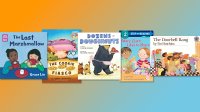Picture Books That Combine Math With Social and Emotional Learning
These eight books for young students promote math and SEL skills, but read with caution: They all feature delicious treats.
Your content has been saved!
Go to My Saved Content.Pie! Cookies! Doughnuts! Do I have your undivided attention? Excellent. Now let’s move forward to discuss math and social and emotional learning (SEL). This isn’t a ruse to lure you into reading this article—the aforementioned treats feature prominently in the eight delicious picture books below. Each title addresses the theme of sharing from two points of view: math and SEL.
From a math point of view: Characters must problem-solve using mathematical operations and strategies, such as fractions and division, to obtain an equal share of tasty treats.
From an SEL point of view: Each of these titles addresses issues stemming from obtaining a fair share of the delicacies. Sharing is a social activity. Reflecting the CASEL framework “Responsible Decision-Making,” the plots of these books include the following scenarios:
- Learning how to make a reasoned judgment after analyzing information, data, and facts
- Identifying solutions for personal and social problems
- Anticipating and evaluating the consequences of one’s actions
Ultimately, the math and social and emotional strategizing work in tandem to create a satisfying resolution for each story. Reading these books as a collection allows for early childhood teachers to have foundational math discussions about division and fractions as well as SEL discussions about the challenges and rewards of sharing.
Finally, each of these picture books has an element of celebration, which can inspire play and allow young children to practice sharing in the context of classroom dramatic play.
- After students read these books as a collection, ask them to list the food mentioned in the stories (e.g., pies, cookies, and doughnuts).
- Brainstorm with students about the materials that they might need to create pictures of these foods (e.g., paper plates, scissors, markers, construction paper).
- Display the books in a prominent and accessible way for children to reference as they create props and develop their play.
- Informally observe and assess the students’ mathematical and social and emotional understanding of sharing as they create and use these props in dramatic play.
Scrumptious Math with a Side of SEL
The Last Marshmallow, by Grace Lin. On a winter day, two children warm themselves up with cups of hot chocolate. Uh-oh! There’s a problem! There are three large marshmallows and two children: How will the children divide the marshmallows equally? Corresponding math activities are available on the publisher’s website and at the end of the book. (Preschool)
Sharing, by Yusuke Yonezu. In this colorful die-cut board book, sad pairs of animals become elated when they figure out how to fairly divide their food in half. Each page turn features a unique mathematical phrase that aligns with dividing food equally in half. (Preschool)
Dozens of Doughnuts, by Carrie Finison, illustrated by Brianne Farley. In anticipation of her upcoming hibernation, Louanne the bear cooks up a dozen doughnuts. What she doesn’t anticipate is all of her friends stopping by. She spends the day cooking dozens of different doughnuts but finds that there are never doughnuts left for her. Finally, Louanne loses her cool, and her friends realize the problem they’ve created, rectifying it by making doughnuts for Louanne. In this video, author Finison reads her book. (Preschool–grade one)
Luna’s Yum Yum Dim Sum, by Natasha Yim, illustrated by Violet Kim. Luna’s family gathers at Round Moon Dim Sum restaurant to celebrate Luna’s birthday. The dim sum cart passes by, and the server delivers two baskets of pork buns to the table. Dividing up the buns seems simple until an accident lands one of Luna’s buns on the floor. How will the buns be divided equally now? There are related math activities available on the publisher’s website and at the end of the book. (Preschool–grade one)
Mary Clare Likes to Share, by Joy N. Hulme, illustrated by Lizzy Rockwell. Mary Clare likes to eat and always shares her food with her friends. Regardless of how many hungry friends there are, Mary Clare finds a way to create equal portions. (Preschool–grade one)
All for Pie, Pie for All, by David Martin, illustrated by Valeri Gorbachev. Grandma Cat makes an apple pie that serves her family with a single piece of pie left over. A family of mice help themselves to the slice, which serves all of them with some crumbs left over. A family of ants eat the crumbs. Soon there’s no more pie, but Grandma Cat suggests making a blueberry pie, and all of the animals help. (Preschool–grade two)
The Doorbell Rang, by Pat Hutchins. Sam and Victoria sit down to enjoy a plate of 12 cookies. Twelve cookies between two children seems like a fair share until the doorbell rings… repeatedly… and with each new visitor there are fewer cookies for each person. Ten guests later, Grandma rings the doorbell and saves the day; she has brought a tray full of cookies for all to share! (Preschool–grade two)
The Cookie Fiasco, by Dan Santat. Four animals are excited for cookie time. Unfortunately, there are only three cookies. Fortunately, a nervous hippo who breaks up the cookies provides the ultimate solution. A corresponding teacher’s guide is available on the publisher’s website. (Kindergarten–grade three)
